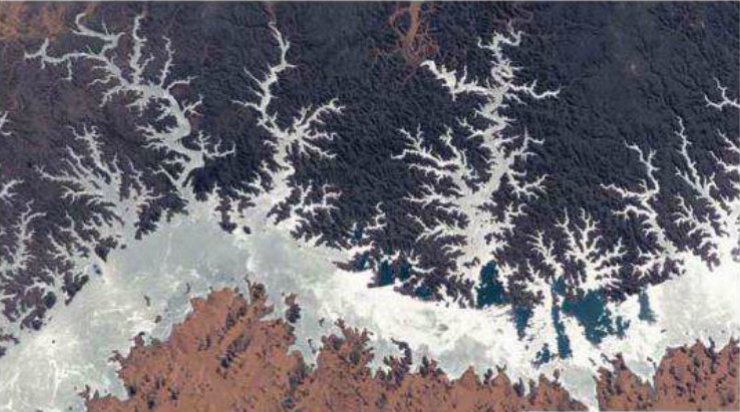The Dahshur royal necropolis, situated about 30 kilometers south of Cairo, Egypt, was once a spectacular hub of ancient activity. This site served as a playground for King Sneferu, who honed his pyramid-building expertise there—skills that laid the foundation for his son, Khufu, to construct the Great Pyramid of Giza. Over the centuries, however, much of what transpired in Dahshur has been lost to neglect, decay, and the relentless march of time. Today, archaeologists are working diligently to uncover the hidden legacy of this ancient necropolis.
A Fractal Signature in the Sand
In the quest to understand the historical modifications to the Dahshur area, archaeologists turned to an unlikely ally: fractal geometry. All over the world, river networks naturally carve intricate fractal patterns into the land. These patterns persist even when the rivers themselves have long vanished. According to Arne Ramisch from the Alfred Wegener Institute for Polar and Marine Research in Potsdam, Germany, these fractals maintain their shape across all scales of magnification.
However, the natural fractal patterns that should have been present around Dahshur, given its location on the fringes of the Western Desert and its proximity to the Nile floodplain, were conspicuously absent. Ramisch and his team used digital topography modeling to study the area and discovered significant deviations from the expected natural geometry.
Anomalies in the Landscape
The absence of natural fractal patterns suggests that the terrain around Dahshur was deliberately altered, likely under the orders of King Sneferu and subsequent pharaohs. These modifications were extensive, spanning at least 6 square kilometers. According to Ramisch, the evidence points to the construction of broad terraces several kilometers in length, which likely enhanced the monumental appearance of the pyramids and surrounding structures.
“This type of modification is subtle and easy to overlook,” says Ramisch. “Even trained eyes might find it hard to grasp the immense footprint left by the ancient Egyptians.”
Monumental Terraces and Modified Landscapes
The terraces identified through the fractal analysis were not merely decorative. They likely served practical and symbolic purposes, adding to the grandeur of the pyramids and possibly facilitating religious or ceremonial activities. These terraces might also have played a role in managing the Nile's floodwaters, supporting agriculture, or providing a stable foundation for construction.
Keith Challis of the University of Birmingham, UK, notes the significance of these findings. “There is a well-established link between human activity and landscape modification. This approach offers an innovative method for identifying such changes.”
Reconstructing Dahshur’s Lost Past
The insights gained from fractal geometry are a small but crucial piece of a much larger puzzle. To reconstruct what has been lost at Dahshur, archaeologists are employing a multidisciplinary approach, combining remote sensing, ground-penetrating radar, and traditional excavation methods.
A Landscape Shaped by Visionaries
King Sneferu’s innovations in pyramid construction are well-documented. His ambitious projects at Dahshur include the Bent Pyramid and the Red Pyramid, both remarkable achievements in their own right. The modifications to the surrounding landscape reflect his vision of creating a harmonious and awe-inspiring environment. These changes were likely continued and expanded upon by later pharaohs, contributing to Dahshur’s significance as a royal necropolis.
A New Frontier in Archaeology
The use of fractal geometry in archaeological research represents a groundbreaking advancement. By analyzing deviations in natural patterns, researchers can uncover traces of ancient human activity that might otherwise remain hidden. In Dahshur, this technique has revealed a vast, human-modified landscape that underscores the ingenuity and ambition of Egypt’s ancient builders.
The Broader Implications
The findings at Dahshur have implications that extend beyond Egypt. The techniques used to identify landscape modifications could be applied to other archaeological sites around the world, shedding light on how ancient civilizations shaped their environments. From the terraces of Machu Picchu to the water management systems of Angkor Wat, the possibilities are endless.
The Legacy of Dahshur
While much of Dahshur’s original splendor has been lost to time, the ongoing research provides a glimpse into the grandeur of this ancient site. The work of Sneferu and his successors not only shaped the physical landscape but also left an indelible mark on Egypt’s cultural and architectural legacy.
In the end, the Dahshur royal necropolis serves as a testament to the ingenuity and vision of ancient Egypt. Through innovative approaches like fractal analysis, archaeologists are uncovering the secrets of this remarkable site, piece by piece, bringing us closer to understanding the grandeur of a bygone era.
This exploration of Dahshur spans multiple dimensions—from the intricate mathematics of fractals to the sweeping ambitions of ancient kings. Each discovery adds a new layer to our understanding of Egypt’s past, revealing a civilization that was as innovative as it was monumental. The story of Dahshur is far from over, and as archaeologists continue their work, they are sure to unearth even more of its hidden treasures.



















0 Comments